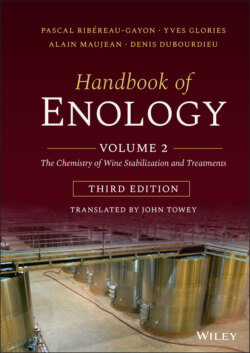Читать книгу Handbook of Enology, Volume 2 - Pascal Ribéreau-Gayon - Страница 40
1.7.3 Rapid Cold Stabilization: Static Contact Process
ОглавлениеThis technique has the major advantage of reducing the artificial cold treatment of wine to four hours, and sometimes less for white wines. Furthermore, the wine no longer has to be maintained at negative temperatures, but only at 0°C, which minimizes not only energy consumption but also frost accumulation on the equipment. A heat‐insulated, conical‐bottomed tank known as a crystallizer is used. It is equipped with a drain to remove excess crystals at the end of the cycle.
Such high‐performance levels can only be achieved with this type of rapid stabilization treatment by seeding with large quantities of cream of tartar (400 g/hl). This large mass of crystals, with a small initial particle size, must absolutely be maintained in suspension by an agitator, taking care to avoid any unwanted aeration (Section 1.5.2). It is also advisable to blanket the wine with inert gas, or at least use an airtight crystallizer.
Treatment effectiveness is monitored by the rapid response analysis described in Section 1.6.4. If the results are satisfactory, agitation is stopped in order to allow most of the tartrate to settle in the conical bottom of the crystallizer. Complete clarification is not easy to obtain. Great care must be taken in using centrifugation as the crystals are highly abrasive. Good results are obtained with horizontal plate filters, using the crystals themselves as the filter layer. Of course, all these operations must be carried out at 0°C.
The static contact process is a very flexible system. It is possible to run two to three cycles per day with volumes of 50–100 hl in each batch. This technology is advisable for small‐ and medium‐sized wineries. The weak point of this system is the price of cream of tartar, but costs may be reduced by recycling tartrate.
In the case of white Champagne base wines, it has proved possible to recycle the tartrate four times, with almost constant treatment effectiveness (Table 1.17). The continued effectiveness of the treatment, even when the tartrate has been recycled four times, has been explained (Maujean et al., 1986). It was shown that the smallest particle size after treatment (<50 μm) was larger than the initial size in the commercial product.
TABLE 1.17 Changes in the Physicochemical Parameters of Cold‐Stabilized Wine When the Contact Tartrate Was Recycled (Maujean et al., 1986)
| Number of times used | K+ (mg/l) | Total acidity (g/l H2SO4) | Tartaric acid (g/l H2SO4) | pH | pC × 105 |
|---|---|---|---|---|---|
| 1 | 315 | 4.93 | 1.59 | 3.11 | 6.83 |
| 2 | 325 | 4.92 | 1.54 | 3.12 | 6.88 |
| 3 | 320 | 4.90 | 1.59 | 3.11 | 6.84 |
| 4 | 300 | 4.98 | 1.83 | 3.09 | 7.35 |
| 5 | 320 | 4.94 | 1.55 | 3.08 | 6.57 |
Of course, recycling is not possible when red wines are treated, as the crystals become coated with phenols and coloring matter and rapidly lose their effectiveness.
